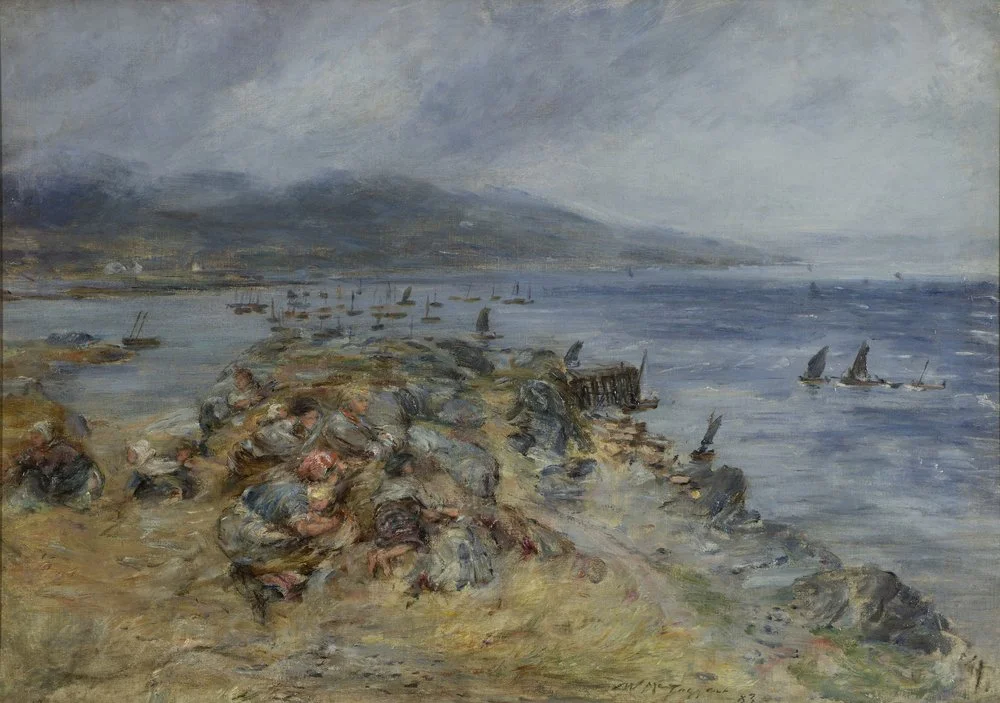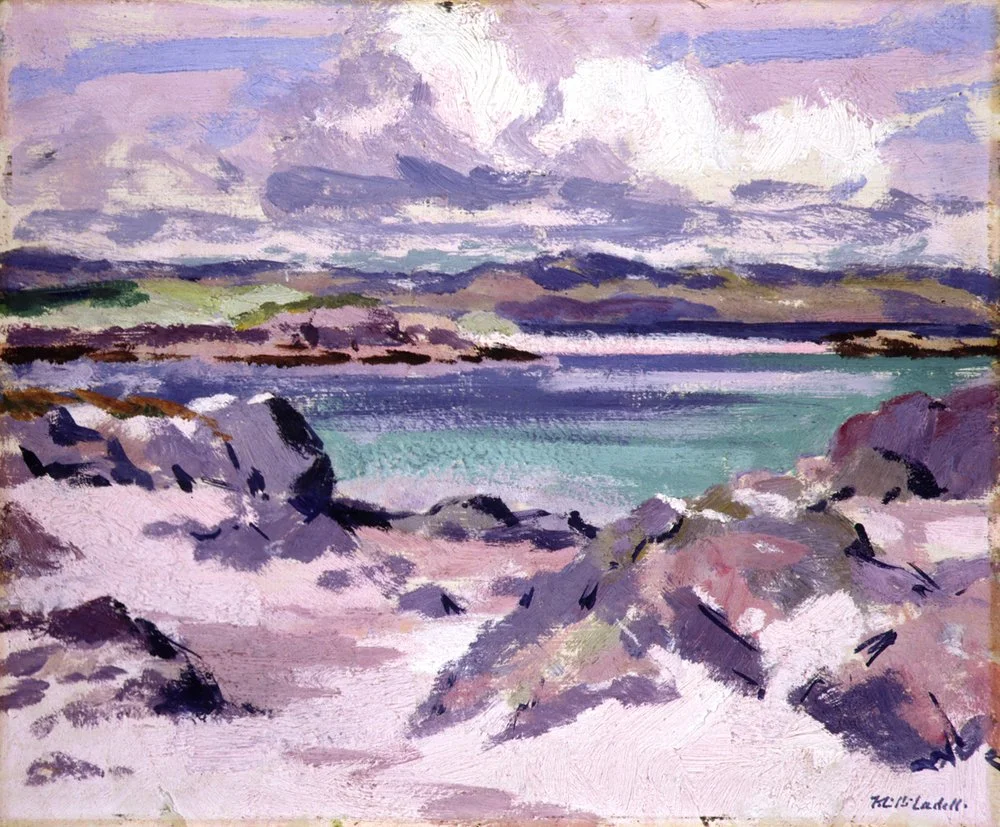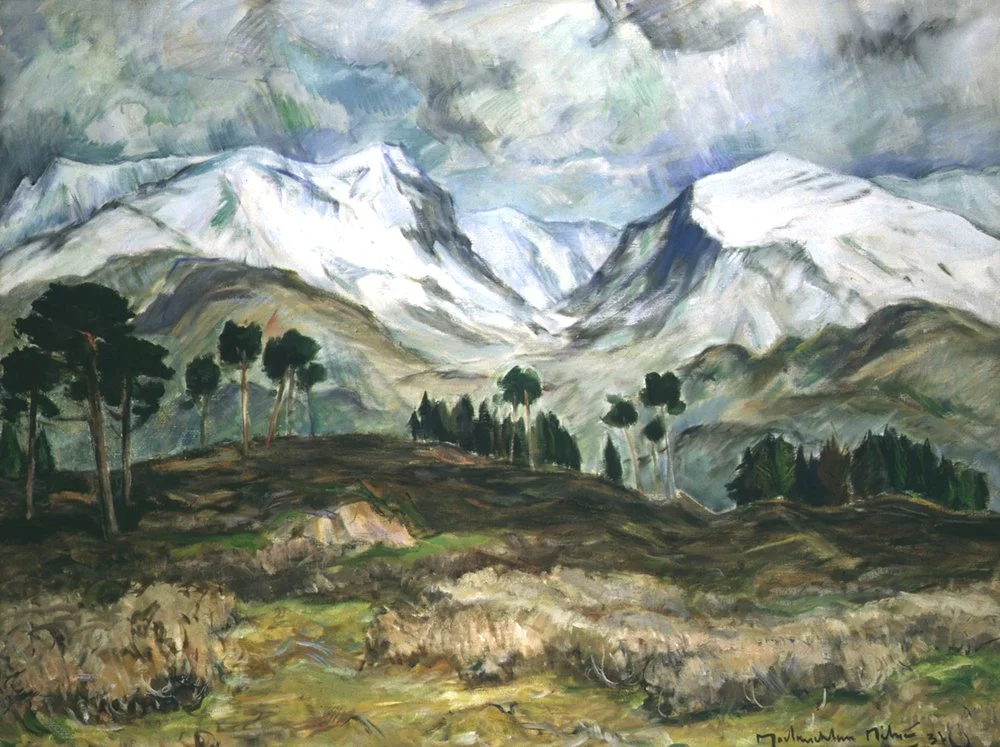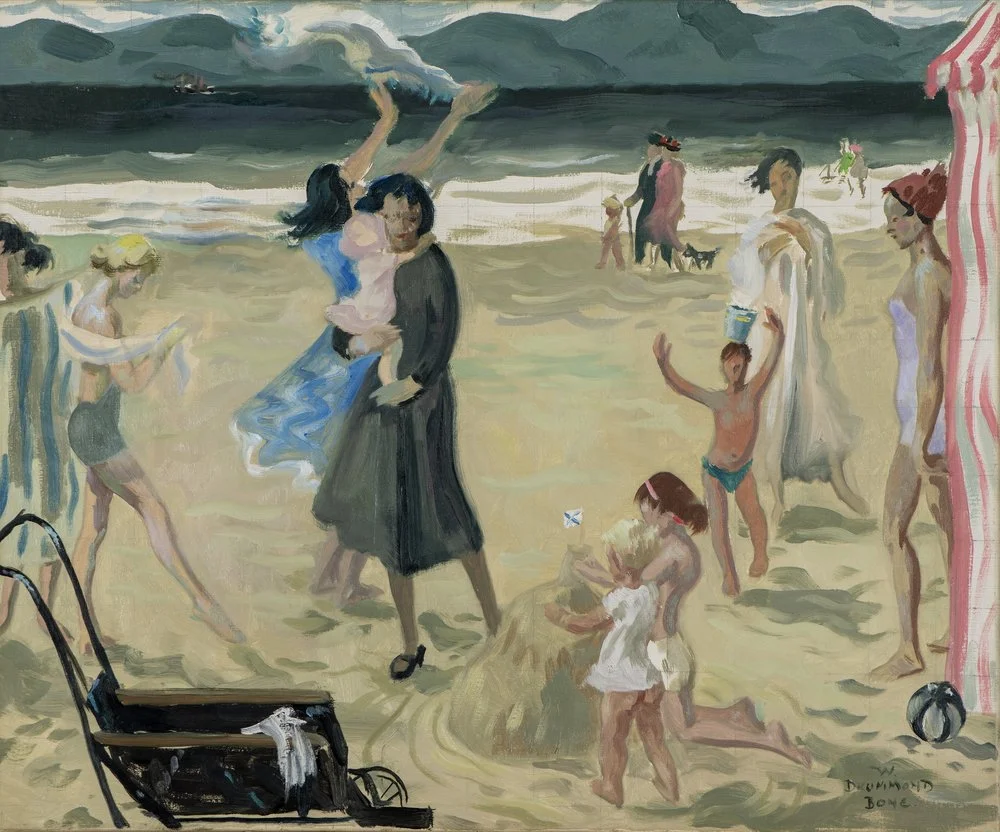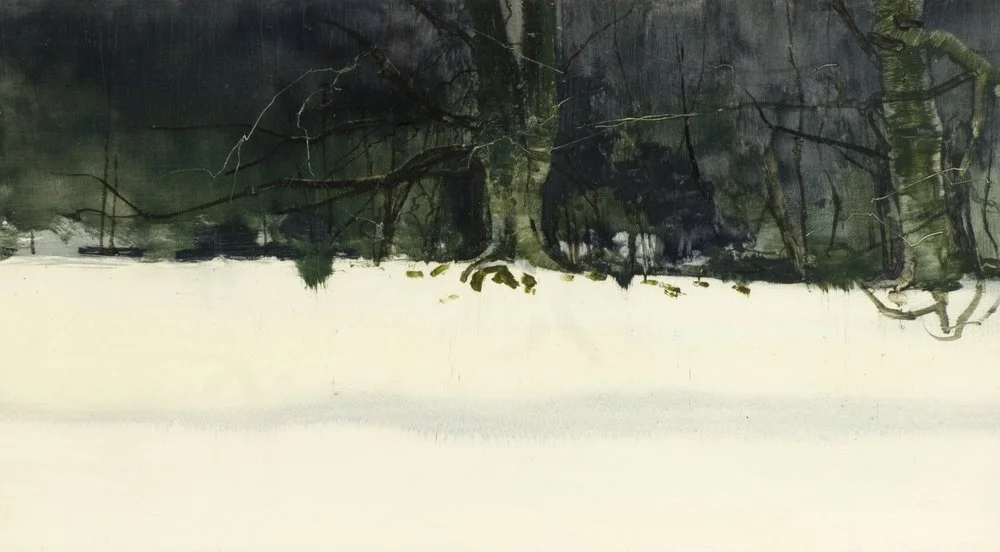
A Weather Eye: Pictures At An Exhibition
Jane Adamson shows Scotland, Scottish art, and Scottish weather to her foreign visitors, from the comfort of The McManus’ A Weather Eye Exhibition, sending them a package of images, all of which she’s annotated with their back stories.
August: the Edinburgh Festival is underway. Visitors descend on the city, some curious to venture further afield. Scotland: what should we see? What should we do?
My answers vary according to interests. And time restraints. In May, two American friends arrived to travel round the coast. With just one day in Edinburgh, I took them from the Castle to Stockbridge, via the Old and New Towns, focussing on writers, poets, philosophers and film makers (they are avid readers). An essential stop was The Oxford Bar on Thistle Street. It is a regular haunt of novelist Ian Rankin and his fictional detective, Inspector Rebus, but it was the Scottish artist Alan Johnston who first introduced me to this legendary pub in the 1980s.
Scottish artists and their loves.
Our day was not long enough to include Scottish Art on our agenda. How could I do that? The answer came later, closer to home.
I would write to them and give them an artist’s tour of Scotland. Here’s what I wrote:
Sunday 11th May 2025
Thought of you both today. Sailing round Scotland, experiencing our island seas and weather.
I am in my local museum and art gallery, the McManus, Dundee. One of my loves. It’s a Victorian building nestling in the heart of the city, with an exceptional art collection. I am savouring the last day of an exhibition called ‘A Weather Eye’. A show which celebrates the rich Scots vocabulary, using it to describe our country’s variable and ever-changing weather, alongside a selection of paintings.
It is in a small gallery, about the size of an Edinburgh drawing room, but with more wall space. It feels intimate, undaunting. We missed out on the Edinburgh galleries so I thought I would walk you round six of the paintings here, to give a flavour of Scottish art.
A taster, if you like, of the Scottish landscape and Scottish artists who know it with a passion.
From the 1880s to the 1980s: here is your local’s guide to Scotland. An insider’s view.
William McTaggart, Wind and Rain, Carradale, oil on canvas, 75 x 106cm, 1883
WILLIAM McTAGGART (1835 – 1910)
Scourie (adjective): Of weather: blustery with rain, wet and squally.
William McTaggart: a titan of the Scottish art world. Fellow artist, JD Fergusson, said he found ‘it difficult to believe that anyone has painted the sea better’.
McTaggart, son of a crofter, was born in a small village near Campbeltown on the West Coast on the Mull of Kintyre, a spit of land which faces the wild Atlantic Coast (next stop America) and to the east, the more sheltered Kilbrannan Sound.
When he was over seventy, he reminisced ‘how he, then little more than a child, had been moved when he saw for the first time, from the rising ground from the south, the loch spread before him, the Kilbrannan Sound and Arran hills beyond, and the fishing fleet going out’. (Note 1)
Carradale is a fishing village not so far north of where McTaggart grew up. But until 1883, when already an established artist in his 40s, he had never painted here. This is his first summer. Renting a house on the bluff above the pier, he worked outside, even on his largest canvases, stimulated by the fresh beauty of his surroundings. See the gusto in his brush strokes. A small canvas, but you can grasp his distinctive style.
Carradale in the 1880s was being frequented by holiday makers, particularly from Glasgow, but its main income was fishing for herring. A fish so abundant that Scotland had the largest fishing industry in Europe. A risky business in these small boats.
The painting shows the returning fleet, coming in with their night catch, women and children sheltering on the headland from the wind, hoping for the safe return of their menfolk. Waiting to help. McTaggart has given us a glimpse into the past.
F.C.B. Cadell, Iona, oil on canvas, 37.5 x 45cm, 1920s
FRANCIS CAMPBELL BOILEAU CADELL (1883-1937)
Leesome (adjective): Of weather: fine, balmy, mild and bright.
From squally to fine weather. It can change in minutes in Scotland. This is the sunlit island of Iona. A sainted paradise. St Columba settled here, from Ireland. He was Scotland’s key saint before the relics of the apostle St Andrew arrived on our eastern shores.
Cadell, born in Edinburgh, was the son of a wealthy surgeon. Much of his work encompassed fashionable Edinburgh New Town interiors and portraits of glamourous women, but he regularly spent summer holidays here, as did many artists (including McTaggart) who were enchanted by its light. White sands, turquoise waters, pink glow in the sky. How refreshing it must have been after the grey stone of Edinburgh.
He was one of the four Scottish Colourists. Never a formal movement or school, The Scottish Colourists only exhibited together on three occasions, but their love of travel and French painting made them hugely influential in Scottish Art.
In the 1920s, Cadell is in his 30s, in his artistic stride. His influences from the early Fauvists and in particular, Matisse can be seen in his colour choices. This has been painted in-situ, outdoors. The exhibition text tells me he used a white gesso ground. ‘This absorbed paint and allowed the artist to work quickly. It also gave a dry chalky finish that enhanced luminosity and was well suited to capturing Iona’s shimmering light.’
A holiday canvas of an island he knew well, for he first came here, almost a decade before.
John MacLauchlan Milne, Lairig Ghru, oil on canvas, 86 x 114cm, 1931 (copyright by permission of John Bleach)
JOHN MACLAUCHLAN MILNE (1885 – 1957)
Banff baillies (noun): the large, white snowy-looking clouds that rise along the horizon.
Moving on into the hills. The Highlands of Scotland. The Lairig Ghru is a mountain pass: a route through the hills for centuries and an old droving track through these central Cairngorms where hundreds of cattle would be driven hundreds of miles from the north to the markets in central Scotland.
Maclauchan Milne had travelled here in a converted World War I Ambulance. It was still a remote area in the 1930s. With few to no accommodation options, he had to provide his own. Complete with studio on wheels.
Maclauchan Milne was the son of a landscape artist, but after a trip to Paris in 1920, he changed his style, adopting a bold more colourful palette. He is often referred to as the fifth Scottish Colourist. A highly talented artist. But as the Colourists did, he also spent time painting on Iona.
The text accompanying this painting says it all: ‘the monumentality of the snow-covered mountains recall the paintings of Paul Cezanne’. Cezanne, his great influence.
And these Banff baillies? The large snowy clouds? Considered the forerunners of foul weather.
William Drummond Bone, A Breezy Day By The Sea, oil on canvas, 62 x 74.5cm, 1950s (copyright by permission of Drummond Bone)
WILLIAM DRUMMOND BONE (1907-1979)
Swaf (noun). A gust, strong puff or swirl (of wind)
By the 1950s the rough weather of World War II had passed, and a different wind had brought in a new era. This painting exemplifies that. Shorelines are no longer places of defence, but playgrounds away from the industrial cities and towns of central Scotland. This is the West Coast; the paddle steamer and hills beyond are the giveaway. Steamers ferrying holidaymakers and those with second homes from Glasgow up and down The Firth of Clyde. Is that the Isle of Arran in the distance?
The artist, William Drummond Bone, was born in Ayr. Son of a local saddler, this is his coast. He spent all his life here. He trained at Glasgow School of Art and won a travelling scholarship in 1931. He went to Europe, returning to teach at Glasgow between 1935 and 1972.
This is painted in the 1950s, in the middle of his career. Confidently and with a verve of brushstroke, he is on home turf. He would be so familiar with the summer wind gusting, hardy souls bathing, and others wrapped up against the flying sand. It would be swirling round them.
The stripes of summer: bathing tents. Towels, shoreline, skylines and slim figures. Sugar rationing post WWII was probably still in place. Summer in 1950s Scotland.
Duncan Shanks, Sunburst, Clyde Valley, oil on canvas, 178 x 178cm, 1979-80 (copyright courtesy of the artist)
DUNCAN SHANKS (Born 1937)
Blue-bore (noun): A rift in the clouds.
The largest canvas of the six. Set in the fertile River Clyde Valley which flows onto Glasgow and into the Firth of Clyde. The river that supported that industrial city and its mighty ship building. This is in its rural heartland.
The artist Duncan Shanks trained at The Glasgow School of Art and like Drummond Bone before him, won a travelling scholarship which took him to Italy for a year. Upon his return in 1961 he took up a teaching post at Glasgow School of Art, where he stayed until 1979.
When I wrote to ask permission to use this painting, it was to him. The only living artist of the six. He kindly replied by handwritten letter, describing his painting process and what he wished to convey.
I will let him fully explain.
‘Sunburst’ was made in my studio from sketch book drawings. The spontaneity of the painting may be misleading for I often paint for years on a canvas during the appropriate season. The painting looks southwest over fields high above the valley. I constantly walked the paths in and above the valley at that time, drawing in my sketch book, mostly in compressed charcoal and pastel, the changing light and atmosphere.” (Note 2)
“The ever-changing sky is a never-ending challenge and passion, and ‘Sunburst’ is one early attempt of many to capture on canvas that ephemeral shaft of light and yellow glow on the hillside.”
“… It was eventually a chance happening which gave focus to the painting…..a shaft of sunlight.”
“… Space, light and movement are the real subjects of the painting.”
“I have had an exhibition in the past called Transience and in my catalogue, (Note 3), I quoted one of my favourite writers Herman Hesse:
‘The heart grieves over the transience of things but surrenders to it without resistance. But the spirit faces it fully armed and constantly renews its bid for victory’.
Hesse referred to the ‘passionate struggle for recall’. He believed that it was the function of the artist to defy the transience of things by describing, pinning down and handing on.”
This painting has done exactly that. The ephemeral shaft of yellow light. The rift in the cloud.
And so, to my last choice of artist and the final work.
James Morrison, The Wood in Winter, oil on board, 31 x 53.5cm, 1981 (copyright permission courtesy of John Morrison)
JAMES MORRISON (1932 JAMES MORRISON (1932-2020)
Cavaburd (noun): a thick fall of snow.
From sunburst and yellow, to a still blue day of cold and snow. A winter scene over on the east of Scotland. A much smaller canvas but no more charged than the last one. For I find the sentiments of both artists similar.
James Morrison studied at Glasgow School of Art and taught at Duncan of Jordanstone College of Art in Dundee.
These are the inland woods he painted many times. A favourite spot. A favourite tree.
As Morrison himself explains in the text for the exhibition:
“The landscape of Angus – a beautiful and largely unspoilt county – is the main concern. Quite deliberately, views which have excited me over the last 35 years have been visited again and their delights and challenges have been faced. Because of the changing weather and the stately skies, we enjoy, the same motifs never pall, and I face each new day before the same subject with the same sense of excitement, anticipation and discovery as I did when I was in my twenties.”
In later life, a documentary, Eye of the Storm (Note 4), was made of Morrison and his paintings. It concerns the impact of climate change and his personal interest in how landscapes in Scotland have been altered.
Would it be so common now to experience a thick fall of snow in Angus?
So, what have I tried to show you with my choice of these six Scottish artists and their paintings? “The same motifs never pall.” And landscapes change over the decades.
Their binding themes? Our weather. The Scottish light. Its exceptional quality. To have so many Scots words for its quixotic nature is not revelatory. It is one of our treasures.
And travel; the European influence. We may be an island nation on its northern edge, but we are never remote from continental ideas.
There you have it: a Scot’s view of Scotland.
Jane Adamson
Acknowledgements:
To Duncan Shanks for writing to me to explain his working process for his painting ‘Sunburst’. My many thanks.
And to Lili Bartholomew of The McManus, for being so supportive.
All of the images are courtesy of Dundee Art Galleries and Museums Collection.
Bibliography:
Note 1: ‘William McTaggart: A Biography and an Appreciation’ by James L. Caw (1917) p5
Note 2: The Hunterian Museum and Art Gallery in Glasgow, holds Shanks collection of sketch books. The curator Anne Delau Beveridge explained their value to the collection:
‘Duncan’s sketchbooks were never intended to be seen by others. As such they offer an uncensored insight into the artist’s working process, thoughts and aspirations. Ideas first explored in these sketchbooks were often subsequently developed into studio studies.’
Note 3: The show Transience received a four-star review from Duncan Macmillan in The Scotsman.
‘For Shanks, it is the restlessness, the constant change even in the most familiar things…..’
Note 4: ‘Eye of the Storm’ Directed by Anthony W. J. Baxter. An hour-long documentary which premiered at the 2021 Glasgow Film Festival.

